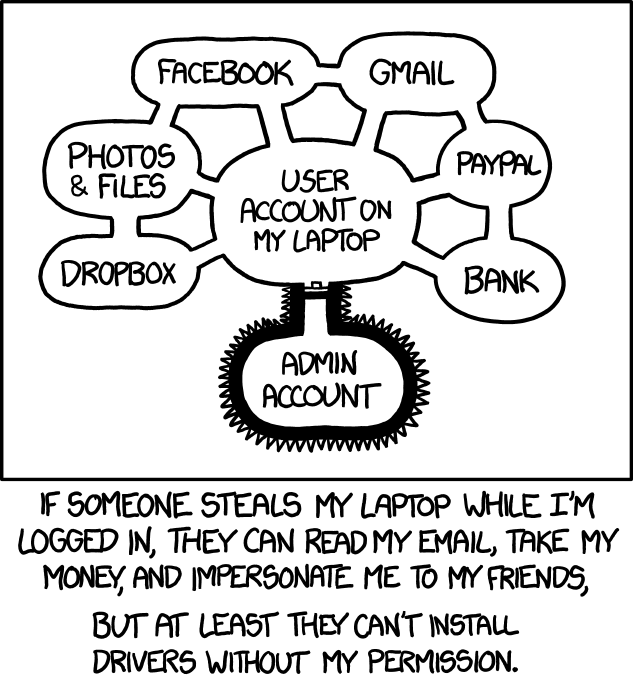I have a few Linux servers at home that I regularly remote into in order to manage, usually logged into KDE Plasma as root. Usually they just have several command line windows and a file manager open (I personally just find it more convenient to use the command line from a remote desktop instead of directly SSH-ing into the system), but if I have an issue, I’ve just been absentmindedly searching stuff up and trying to find solutions using the preinstalled Firefox instance from within the remote desktop itself, which would also be running as root.
I never even thought to install uBlock Origin on it or anything, but the servers are all configured to use a PiHole instance which blocks the vast majority of ads. However, I do also remember using the browser in my main server to figure out how to set up the PiHole instance in the first place, and that server also happens to be the most important one and is my main NAS.
I never went on any particularly shady websites, but I also don’t remember exactly which websites I’ve been on as root, though I do seem to remember seeing ads during the initial pihole setup, because it didn’t go very smoothly and I was searching up error messages trying to get it to work.
This is definitely on me, but it never crossed my mind until recently that it might be a bad idea to use a browser as root, and searching online everyone just states the general cybersecurity doctrine to never do it (which I’m now realizing I shouldn’t have) but no one seems to be discussing how risky it actually is. Shouldn’t Firefox be sandboxing every website and not allowing anything to access the base system? Between “just stop doing it” and “you have to reinstall the OS right now there’s probably already a virus on there,” how much danger do you suppose I’m in? I’m mainly worried about the security/privacy of my personal data I have stored on the servers. All my servers run Fedora KDE Spin and have Intel processors if that makes a difference?
You seriously need to stop what you’re doing. Log in with ssh only. If you need multiple terminals use multiple ssh sessions, or screen/tmux. If you need to search something do it on your desktop system.
The server should not have Firefox installed, or KDE, or anything related to desktop apps. There’s no point and nothing good can come of it.
This. Thread should have officially ended here.
Yeah there’s a bit of scope to review what op is doing here.
Why is there even a DE on a server if it’s headless. If it’s not headless why not write up some Dockerfiles and manage it from a non-root account?
Are the services running as root?
Also, is it being accessed via wireguard/ovpn? It would be unwise to run a server as root with an open port.
came to say this
I think there are many security issues with your setup. You really, really shouldn’t do everything as root. That is just a time bomb waiting to blow.
Your frame of mind is “dangerous”. If you are browsing on your servers as root, you need to not manage servers anymore. If that sounded harsh, learn about attack surface area first and then I might let you back in the server room.
You won’t find discussions about running browsers as root because it’s not something you should need to discuss. Also, you don’t need to be browsing “shady” websites to get compromised. Get that myth out of your head.
find it more convenient to use the command line from a remote desktop instead of directly SSH-ing into the system
How is extra steps and added latency more convenient? The latency of a console via remote desktop would drive me crazy. Hell, I haven’t installed any kind of desktop environment on Linux server for over 20 years. It’s not needed and a waste of resources. Who needs file managers anyway?
Is it actually dangerous to run Firefox as root?
Yes, very. This is not specific to Firefox, but anything running as root gets access to everything. Only one thing has to go wrong for the whole system to get busted.
usually logged into KDE Plasma as root.
Please don’t do this! DEs are not tested to be run as root! Millions of lines of code are expected to not have access to anything they shouldn’t have and as such might be built to fail quietly if accessing something they shouldn’t in the first place. Same thing applies to Firefox, really.
Please don’t do this! DEs are not tested to be run as root! Millions of lines of code are expected to not have access to anything they shouldn’t have and as such might be built to fail quietly if accessing something they shouldn’t in the first place. Same thing applies to Firefox, really.
Could you elaborate on this? I’m genuinely surprised because Fedora just asks you if you want to have the option to log into root from KDE during installation, so I always just assumed that it’s intended to be used that way.
I don’t know the specifics on Fedora’s installer, but normally that question is about disabling root account, not logging into a DE.
Not sure what else to elaborate here. There’s a bunch of code that is not tested to be run as root. A whole class of exploits becomes unavailable, if you stick to an unprivileged user.
Say there’s some exploit that allows some component of KDE to be used to read a file. If it’s running under an unprivileged user - it sucks. Everything in user’s homedir becomes fair game. But if it runs as root - it’s simply game over. Everything on the system is accessible. All config, all bad config, files of all applications (databases come to mind). Everything.
Thank you.
Say there’s some exploit that allows some component of KDE to be used to read a file. If it’s running under an unprivileged user - it sucks. Everything in user’s homedir becomes fair game. But if it runs as root - it’s simply game over. Everything on the system is accessible. All config, all bad config, files of all applications (databases come to mind). Everything.
This is also something I’m thinking about: All the hard drives mounted on the server is accessible to the only regular user as that is what my other computers use to access them. I’m the only one with access to the server so everything is accessible under one user. The data on those drives is what I want to protect, so wouldn’t a vulnerability in either KDE or Firefox be just as dangerous to those files even running as the regular user?
Also, since my PC has those drives mounted through the server and accessible to the regular user that I use my PC as, wouldn’t a vulnerability in a program running as the regular user of my PC also compromise those files even if the server only hosted the files and did absolutely nothing else? Going back to the Firefox thing, if I had a sandbox breach on my PC, it would still be able to read the files on the server right? Wouldn’t that be just as bad as if I had been running Firefox as root on the server itself? Really feels like the only way to 100% keep those files safe is to never access them from an internet accessible computer, and everything else just falls short and is just as bad as the worst case scenario, though maybe I’m missing something. Am I just being paranoid about the non-root scenarios?
How does a “professional” NAS setup handle this?
You never log in as root. On every new VM/LXC I create, I delete the root password after setting it up so that my regular user can use sudo.
Run as your regular user and sudo the commands that need privileges.
Also if these are servers, run them headless. There’s no need for a GUI or a browser (use wget or curl for downloads, use your local browser for browsing)
You keep your files safe by having backups. Multiple copies. Set up the backups to gets copied to another server or other system your regular user doesn’t have access to. Ideally, you follow the 3-2-1 backup standard if the files are important. That is 3 copies, on 2 different media, and 1 offsite. There are many ways of accomplishing that and its up to you to figure out what works best.
I have no clue how dangerous running Firefox as root is, but it begs the question…why would you do that?
Create a user account for managing things and create a separate user for each service and/or containers.
For managing things use tmux with ssh, if you want to manage files etc. just use ranger/lf/mc. One can also mount the file system with sshfs.
Yes, it is. As a user you compromise only that user as a consequence of some sandbox escape. Then there may or may not be some successful privilege elevation.
but no one seems to be discussing how risky it actually is.
That is because people stopped doing it ages ago.
But shouldn’t Firefox be sandboxing every website and not allowing anything to access the base system?
Security is always a matter of layers. Any given layer can fail some of the time but you want to set up your security so situations where all the layers fail together are rare.
My goodness
It’s about as dangerous as using IE in the old days, or Edge in administrator mode.
Realistically it’s not super dangerous, and no you probably don’t have a virus just from browsing a few tech support sites, but you do eliminate your last line of defense when you run software as root. As you know, root can read/change/delete anything on your system whereas regular users are generally restricted to their own data. So if there is a security problem in the software, it’s made worse by the fact that you were running it as root.
You are right though that Firefox does still have its own protections - it’s probably one of the most hardened pieces of software on your computer exactly because it connects to the whole wide internet - and those protections are not negated by running as root. However if those protections fail, the attacker has the keys to the kingdom rather than just a sizable chunk of the kingdom.
To put that in perspective though, if there is a Firefox exploit and a hacker gets access to your regular user account, that’s already pretty bad in itself. Even if you run as a regular unprivileged user they would still have have access to things like: your personal documents, your ssh keys, your Firefox profile with your browsing history, your session cookies and your saved passwords, your e-mail, your paypal account, your banking information, …
As root, they could obviously do even more like damage like reading all users’ data, installing a keylogger or screengrabber, installing a rootkit to make themselves undetectable, but for most regular users most of the damage is already done when their own account is compromised.
So when these discussions come up, I always have to think about this XKCD comic:

They might have access to all that data once but a lot of the paths towards making that a persistent threat that doesn’t go away after the next reboot and most of the ones towards installing something even deeper in the system that might even survive a reinstall do require root.
That’s what I said yes.
This is like removing a safety feature in your car. Like removing seatbelts or maybe anti-lock brakes.
I don’t want to step on your workflow too much since it somehow seems to work for you but your main issue stems from the fact that you clearly don’t work with your server as if it actually was a server.
You shouldn’t really have a desktop interface running there in the first place (let alone as root and then using it as a regular user). You should ask yourself what it actually solves for you and be open to trying different (and more standard) solutions to what you’re trying to achieve.
It’d probably consist of less clicking and using the CLI a bit more, but for stuff like file management you can still easily use
mc.If you need terminal sessions that keep scrollback and don’t stop when you disconnect you should learn to use
tmuxorscreenor something like that. But then again if you’re running actual software in there then you should probably use a service (daemon) for that.As for whether it’s a security issue, yeah it most definitely is. Just like it’s a security issue to run literally any networked application as root. Security isn’t black and white and there are trade offs to be made but most people wouldn’t consider what you’re doing a reasonable tradeoff.
I had actually moved from a fully CLI server to one with a full desktop when I upgraded from a single board computer to x86. The issue is that it’s not just a NAS, but I regularly use it to offload long operations (moving, copying, or compressing files, mostly) so I don’t need to use my PC for those. To do that I just remote into it and type in the command, then I can turn my PC off or do whatever without affecting the operation. So in a way it’s a second PC that also happens to be a server for my other machines.
I use screen occasionally, and I used to use it a lot more when it was CLI only, but I find it really unwieldy due to how it manages multiple active terminals where you have to type in the ID of each screen to go back into it, and also because it refuses to scroll even when run in a terminal emulator that supports scrolling, where it just cycles between recent commands when you move the scroll wheel.
Not trying to make excuses, just trying to explain my reasoning. I know it’s bad practice and none of these are things I’d do if I was managing an actual production server, but since it’s only accessible from my LAN I tend to be a lot more lax with it.
I’m wondering if I could benefit from some kind of virtualized setup that separates the server stuff while still letting me remote into a desktop on the same machine for doing stuff, or if I can get away with just remoting into not the root user. Though I’ve never used a hypervisor and have no idea how to so I’m not sure how well that would go, since the well-known open source ones like Xen seem really technical and really feels like something not meant to be used outside an actual data centre.
I see. In that case you should really try tmux; I didn’t vibe with screen either but I find tmux quite usable.
For the most part I just open several terminal windows/tabs on my local machine and remote with each one to the server, and I use tmux only when I explicitly need to keep something running. Since that’s usually just one thing I can use like two tmux commands and don’t need anything else.
Oh and for stuff like copying and such I’d use
rsyncinstead of primitivecpso that in case it gets interrupted I only copy what’s needed.I wouldn’t bother with virtualization and such; you’d only complicate things for yourself. Try to keep it simple but do it properly: learn some command line basics and you’ll see that in a year it’ll become second nature.
Sorry, this is very much a PEBKAC issue. This is a excerpt from my
tmuxconfig:# Start windows and panes at 1, not 0 set -g base-index 1 setw -g pane-base-index 1 # Use Alt-arrow keys without prefix key to switch panes bind -n M-Left select-pane -L bind -n M-Right select-pane -R bind -n M-Up select-pane -U bind -n M-Down select-pane -D # Shift arrow to switch windows bind -n S-Left previous-window bind -n S-Right next-window # No delay for escape key press set -sg escape-time 0 # Increase scrollback buffer size from 2000 to 50000 lines set -g history-limit 50000 # Increase tmux messages display duration from 750ms to 4s set -g display-time 4000 # Bind pane creation keys to reuse current directory bind % split-window -h -c "#{pane_current_path}" bind '"' split-window -v -c "#{pane_current_path}"I hope the comments are self explanatory.
Scrolling works with
Ctrl+b Page Up/Down. There are other shortcuts, but this is probably the most obvious.qto quit scrolling.Ctrl+b dto detach from a session.tmux ato attach. As always, many options are available to have many named sessions running simultaneously, but that is for a later time.I’d go for remoting in as not root as the first (and maybe only) step for better security.
From there, running the services in VMs would probably be the next step. Docker might be better, but I have gotten into that yet myself.
As for hypervisor, KVM has worked great for me.
KVM is awesome. It is the core of Proxmox which is my preferred way to manage VMs and LXC containers now. I used to run debian+KVM+virt-manager or cockpit but Proxmox does all the noodling setup for me and then just works.
Usig anything as root is a security risk.
Using any UI application as root is a bigger risk. That’s because every UI toolkit loads plugins and what not from all over the place and runs the code from those plugins (e.g. plugins installed system wide and into random places some environment variables point to). Binary plugins get executed in the context of the application running and can do change every aspect of your program. I wrote a small image plugin to debug an issue once that looked at all widgets in the UI and wrote all the contents of all text fields (even those obfuscated to show only dots in the UI) to disk whenever some image was loads. Plugins in JS or other non-native code are more limited, but UI toolkits tend to have binary plugins.
So if somebody manages to set the some env vars and gets root to run some UI application with those set (e.g. using sudo), then that attacker hit the jackpot. In fact some toolkits will not even bring up any UI when run as root to avoid this.
Running any networked UI application as root is the biggest risk. Those process untrusted data by definition with who knows what set of plugins loaded.
Ideally you run the UI as a normal user and then use sudo to run individual commands as root.
So is the main worry with GUIs that they have potential code execution vulnerabilities? Or is the worry that the plugins themselves are malicious?
Plugins are a code execution vulnerability by design;-) Especially with binary plugins you can call/access/inspect everything the program itself can. All UI toolkits make heavy use of plugins, so you can not avoid those with almost all UI applications.
There are non-UI applications with similar problems though.
Running anything with network access as root is an extra risk that effects UI and non-UI applications in the same way.
I just wanted to add that you can run gui applications through ssh with x11 forwarding, options -X or -Y (untrusted/trusted but at least in Debian back in the day they behaved the same). So if you wanted a gui file manager you run it in the ssh session on the remote server, sudo if you need but NEVER logged as root, and the window will pop on your local DE instead of having to run an entire desktop on each server
You should learn how to use ssh. Running Firefox on top of Xorg is a disaster waiting to happen.












